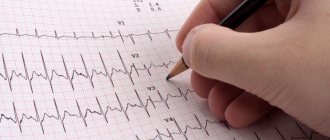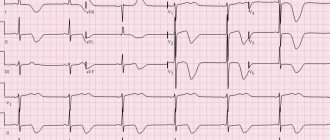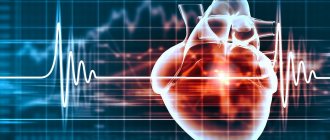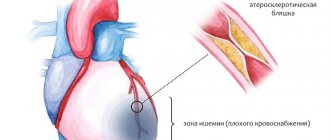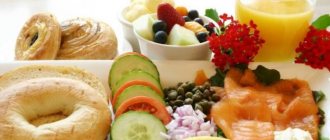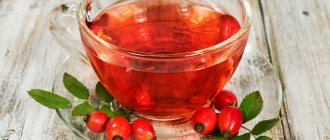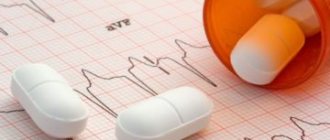Nuances of diet for ischemic heart disease and angina pectoris
Therapy for heart disease involves following nutritional rules that help avoid stress on the cardiovascular system and make treatment more effective. The main emphasis is on reducing the caloric content of food, which also contributes to weight loss. The diet for coronary artery disease and angina pectoris involves monitoring the intake of solid fats of animal origin, since they are the main source of cholesterol. Deposits on the walls of blood vessels of this organic compound can lead to atherosclerosis, one of the leading causes of angina.
Recommendations for weight loss
The presence of excess kilograms further worsens the condition of patients suffering from myocardial pathologies. Therefore, in order to lose weight, they need to follow the rules of a healthy diet. A diet for coronary artery disease and obesity allows you to reduce weight (up to 1 kg in 7 days) without harm to health. According to doctors, it also helps normalize blood glucose levels, prevents the development of hypertension, improves the condition of the skin, physical stability and quality of life in general. Patients are recommended to exercise at least 5 times a week (workouts can be replaced by brisk walking) and weigh themselves twice a month. In addition, patients should remember the following rules:
- You should not consume more than 150 g of meat products per day.
- It is necessary to give up processed foods, butter, sausages, smoked meats, and fast food.
- Include dishes from lean varieties of fish in your diet. They should be consumed at least twice a week.
- Reduce the amount of coffee and tea.
- Limit alcoholic drinks or avoid them completely. You are allowed to drink no more than 1 glass of wine per day.
- Choose low-fat cheeses and low-lipid dairy products.
- Dishes should be stewed, boiled or baked.
- Eat enough fruits, berries, and vegetables.
The diet for coronary artery disease for patients who are overweight should be drawn up by the attending physician, taking into account the state of health, the number of excess kilograms, physical activity, age category and gender.
Definition of coronary artery disease and angina pectoris
Coronary heart disease (CHD) is a disease that combines myocardial infarction, angina pectoris, and atherosclerotic cardiosclerosis. The main reason for the development of the disease is the lack of blood supply to the coronary arteries of the heart, which leads to a narrowing of their lumen. This is actively promoted by cholesterol, which is deposited on the walls of blood vessels in the form of so-called cholesterol plaques. They impede the movement of blood, resulting in pain behind the sternum (“angina pectoris”), which is a sign of angina pectoris.
The question “Angina pectoris - what is it?” many people ask. This is one of the components of IHD. It usually manifests itself as a painful sensation during and after exercise. Angina increases the risk of heart attack and requires immediate treatment.
Angina pectoris can occur in stable and unstable forms. The first is characterized by pain during physical activity or emotional stress. The second is characterized by changes in symptoms: the nature and strength of pain, the place of its sensation may change
Features of nutrition for coronary artery disease and angina pectoris
A diet for angina pectoris and cardiac ischemia involves a drastic reduction in salt intake. It is also recommended to consume more greens to provide the body with sodium and potassium. Most often, for the diseases in question, diet No. 10 is prescribed, which helps reduce the load on the heart and strengthen it. The effect is achieved by normalizing blood circulation and providing the body with all the necessary substances.
Diet for coronary artery disease and angina pectoris, table number 10 involves consuming up to 90 g of protein per day, up to 70 g of fat, approximately 400 g of carbohydrates, no more than two liters of liquid (water, tea, soup, etc.) and up to 7 g of salt. The number of meals is from four to six.
Eligible products
| Cereals | Any |
| Vegetables and herbs, baked or raw | Carrots, tomatoes, lettuce, cabbage, potatoes, beets, pumpkin, zucchini |
| Fish and meat, stewed, boiled, but not fried | Lean types of meat - veal, beef, chicken, turkey Fish - herring, trout, sardine. |
| Chicken eggs | 1 per day, preferably soft-boiled |
| Ripe fruits and berries | Any |
| Dairy | Milk, cottage cheese, kefir |
| Beverages | Weak - tea, coffee with milk, juices, rosehip decoction |
| Nuts, dried fruits. | Walnuts, raisins, prunes. |
Products whose consumption is partially limited
For ischemic heart disease and angina, partially limit the consumption of white cabbage and green peas. Other products include dietary low-fat sausage. As for dairy products, sour cream, cheese and cream can be consumed to a limited extent. Consumption of foods containing fats is limited: butter and ghee. Drinks that can be consumed in limited form include grape juice and green tea.
Prohibited products
| Beverages | Alcohol, coffee, strong tea, any broths |
| Fat meat | Pork, lamb, duck |
| Bakery products | Baked goods, salted dough, fresh bread |
| Vegetables | Legumes, radishes, spinach, sorrel, radish, garlic, mushrooms, onions, corn |
| Sweets | Chocolate, ice cream, cakes |
| Sausage | Smoked and dried, |
| Fish products | Canned food, caviar |
| Canned products | Salted, pickled and pickled vegetables |
The restriction in eating meat and fish depends on the fat content in them. If fatty meats are not recommended for consumption at all, then mackerel is allowed in limited quantities
What can you include in your diet?
According to the principles of the diet for angina pectoris (table No. 10), the patient’s menu should contain the following products:
- Bread and pastries of the second grade, made from rye flour, with the addition of bran.
- Vegetable fats (sunflower oil, olive oil). It is better to season ready-made dishes with them, but not to use them for frying.
- First courses made from vegetables (cabbage soup, borscht, beetroot soup). Soups with added rice or other grains should be limited.
- Lean varieties of meat and poultry (beef pulp, skinless chicken breast, turkey) boiled or baked.
- Skinny fish.
- Seafood delicacies, kelp salads.
- Vegetables (eggplant, pumpkin, carrots, beets, bell peppers, zucchini, cabbage, potatoes). It is advisable to eat them boiled or stewed.
- Low-fat dairy products (yogurt, sour cream, cottage cheese).
- Cereal dishes cooked in water (rice and semolina should be limited).
- Eggs (no more than three per week), steamed egg white omelettes.
- Fruits and berries, jellies and fruit drinks with a small amount of granulated sugar or its substitute.
- Lightly brewed tea with added milk, chicory, fruit juices (freshly squeezed), rosehip drink.
- Nuts of all varieties.
- Dried fruits.
- Greens (lettuce, spinach, dill, fennel, parsley).
Sample menu for the week
The peculiarity of the diet involves taking permitted foods throughout the week. The weekly menu for angina pectoris can and should be varied. Distribution of dishes usually occurs individually. You can choose your options from the menu below.
- Breakfast – oatmeal, soft-boiled egg and tea.
- Lunch – boiled fillet with vegetables or vegetable soup. From drinks you can choose compote.
- Dinner – mashed potatoes with boiled fish, kefir.
- Breakfast – cottage cheese with fruit and tea.
- Lunch – baked potatoes with beef stroganoff, vegetarian borscht, coffee with milk.
- Dinner – pilaf with boiled meat, compote, green vegetables.
- Breakfast – milk soup, tea.
- Lunch – fish cutlets with vegetables, beetroot soup, compote.
- Dinner – buckwheat with boiled veal, baked vegetables, tea.
- Breakfast – cottage cheese casserole, fresh juice.
- Lunch – pasta with chicken, tea.
- Dinner – buckwheat porridge, meatballs, salad, tea.
- Breakfast – juice, fruit pilaf.
- Lunch – chicken cutlets, vegetable soup or vegetarian borscht.
- Dinner – mashed potatoes with boiled or stewed fish.
- Breakfast – omelet, juice or green tea.
- Lunch – stewed vegetables, chicken cutlets, compote.
- Dinner – vinaigrette, boiled chicken, kefir.
- Breakfast – milk soup, tea.
- Lunch – potato soup with buckwheat or chicken fillet with vegetables.
- Dinner – fish cutlets with baked vegetables, compote.
For lunch and afternoon snack, you can choose yoghurts, baked and fresh fruits, kefir, jellies, mousses, cottage cheese and other easily digestible foods.
Diet for angina and coronary heart disease limits the consumption of foods containing cholesterol in order to improve vascular permeability and ensure blood access to the heart. Of course, diet alone cannot overcome the disease, but proper nutrition can have a positive effect on the body: reduce excess weight, help in therapy and at the same time provide the body with all the necessary nutrients.
Features of the Mediterranean diet
For angina pectoris, as well as after myocardial infarction, a Mediterranean diet is prescribed, which is also anti-atherosclerotic. Scientists have conducted studies that have shown that it reduces the incidence of many heart ailments by 3.1 times. The essence of the diet is the correct ratio of proteins, fats, carbohydrates, vitamins and minerals. So, you must adhere to the following rules:
- Reduce your saturated fat intake to 7-10%. Thus, only small quantities of butter, hard margarine, hard and soft cheeses, meat fat (visible), duck, goose, cakes, and cream are allowed.
- Increase to 10-30% the daily share of high-protein foods that are low in saturated fat. These are fish, chicken, turkey, veal.
- Consume 35 g of fiber per day, getting it from vegetables, fruits, unpolished grains, lentils, beans, rice, and cereal mixtures.
- Increase your consumption of polyunsaturated fats to 7-10%, and monounsaturated fats to 10-15%. So, you can use olive, sunflower, corn, and soybean oil in cooking.
- Consume no more than 300 mg of cholesterol per day. So, you can’t eat: more than 1-2 egg yolks per week, more than 2 servings of liver per month. Eliminate all other products.
Taking into account these rules, the menu for the week is proposed:
| Day | Breakfast | Dinner | Dinner |
| Monday | Oatmeal with berries, a glass of cherry juice. | Wheat porridge, steamed minced chicken cutlets, a slice of rye bread, green apple compote. | A piece of boiled beef, a salad of green vegetables and tomatoes, a glass of milk. |
| Tuesday | Oatmeal pancakes with honey, a glass of herbal tea. | Baked chicken fillet with vegetables - potatoes, zucchini, carrots, tomatoes. | Baked fish fillet and seaweed salad drizzled with olive oil and lemon juice dressing. |
| Wednesday | Cheesecakes with fresh berries, green tea. | Buckwheat with chicken pieces, dried fruit compote. | Steamed fish cutlets, leafy green salad, glass of milk. |
| Thursday | Cereal cookies, a glass of kefir. | Vegetable soup with a slice of rye bread. | Vegetable stew, baked chicken breast. |
| Friday | Buckwheat pancakes, 2-3 slices of melon. | Lenten borscht with dark grain bread, compote. | Stewed vegetables with baked potatoes and boiled chicken fillet. |
| Saturday | Cottage cheese with fruit, chamomile tea. | Wholemeal pasta with stewed rabbit and green vegetable salad, compote. | Boiled chicken with fresh vegetables - tomato, cucumber, green peas. |
| Sunday | Cereal cookies, weak black tea with honey. | Baked fish with vegetables, buckwheat porridge, a glass of freshly squeezed orange juice. | Stewed chicken fillet with fresh vegetable salad, a glass of kefir. |
Reducing cholesterol levels
The cause of high cholesterol is excessive consumption of animal and cooking fats. To normalize cholesterol levels, we refuse fatty meats (pork, goose, duck), offal, canned meat, lard and sausages, butter and spreads, mayonnaise, all types of butter dough, fatty cheeses and homemade sour cream.
We often eat vegetable oils: corn, olive, sunflower, sesame, flaxseed. Nutritionists recommend eating sea fish rich in polyunsaturated fatty acids. Omega-3 helps normalize cholesterol metabolism.
Porridge should be the basis of the diet for heart disease. The championship in the fight against cholesterol is firmly entrenched in oatmeal, rich in B vitamins and microelements. Vegetables, fruits, berries add variety to your table. Nuts, dried fruits, and honey will be a useful and tasty addition to therapeutic nutrition.
Authorized Products
People suffering from angina pectoris, as well as hypertension, should place greater emphasis on the following foods :
- Most porridges, especially buckwheat and millet, as they contain vitamin B, potassium, calcium, magnesium and other elements. Buckwheat contains rutin, which also affects proper metabolism in the body.
- Boiled rice mixed with dried apricots and raisins. This dish is called kutia. It is rich in potassium and magnesium, and is also a natural adsorbent.
- Wheat contains many vitamin complexes and elements, regulates carbohydrate metabolism.
- Oatmeal – cleanses the body, including cholesterol formations.
- Barley porridge is rich in many microelements.
- Seaweed - improves metabolic processes.
- Plant foods in the form of fruits and vegetables.
- Banana and honey, as they contain potassium, an element that is good for the heart.
- Legumes, which contain fiber and complex carbohydrates.
- Vegetable oils.
- Meat and fish products, low-fat.
- Poultry meat.
- Milk products.
- Raisins, nuts, prunes, they also contain potassium in sufficient quantities.
Diet menu for angina pectoris (Diet)
Description current as of 06/09/2017
- Efficacy: the therapeutic effect is achieved after 2 months
- Timing: constantly
- Cost of food: rubles per week
Angina pectoris is a variant of the course of coronary heart disease, and is characterized by the appearance of discomfort or pain in the chest.
Attacks of pain are associated with transient myocardial ischemia that occurs at the height of the load. At this time, the myocardial need for oxygen increases, but due to the narrowing of the coronary vessels, its delivery deteriorates.
In most cases, attacks appear against the background of physical stress (emotional), after eating or in cold weather, when walking against the wind, leaving a warm room in the cold. In addition, certain conditions (arterial hypertension, hypertrophic cardiomyopathy, aortic stenosis) can also cause attacks.
The main symptom of angina is chest discomfort or pain, which can be mild and not cause concern, or severe, manifested as intense compression in the precordial area.
Some patients experience atypical symptoms: bloating, dyspeptic symptoms, gas formation. At the height of the attack, an increase in heart rate and pressure are observed. Typically, attacks go away at rest or after taking nitroglycerin.
Treatment may include antiplatelet drugs, nitrates, calcium channel blockers, beta blockers, and statins. Nutrition is of no small importance in this disease. An increase in cholesterol and LDL fractions in the blood leads to the progression of atherosclerosis and narrowing of the lumen of blood vessels.
The diet for angina pectoris is aimed at slowing the progression of atherosclerosis. It is aimed at eliminating lipid metabolism disorders, weight loss and improving blood circulation.
General principles of nutrition:
- Reducing animal fats and carbohydrates (easily digestible). When cooking, you need to trim off the fat, remove the fat rendered during cooking and remove the skin from the bird. The degree of restriction of fats and carbohydrates depends on the patient’s weight.
- Normal protein content.
- Restriction of salt (4 g), cholesterol (0.3 g) and extractives.
- The content of linoleic acid, lipotropic substances, dietary fiber, potassium and magnesium has been increased due to an increase in vegetable oils, seafood, vegetables, fruits and cottage cheese in the diet.
- Increasing the proportion of products containing iodine (seaweed, mussels, sea fish, squid, shrimp).
- Exclusion of products that stimulate the cardiac and nervous systems (coffee, tea, alcohol, cocoa).
- Meals 5 times a day, in small portions.
All products of animal origin contain cholesterol, but there are products with a high content of it, so-called “cholesterol concentrates”: brains, mayonnaise, margarine, offal, egg yolk.
As it turned out, the danger is not the cholesterol that comes with food, but the lack of the required amount of fiber in food (vegetables, fruits, bran). In this regard, the diet provides for an increase in the proportion of plant foods in the diet.
- Wheat bread, grade II, grain, with bran, rye. Homemade baked goods with wheat bran and no salt.
- Refractory fats are excluded and half the amount of fats is replaced with vegetable oils.
- Vegetarian soups, you can prepare cabbage soup, beetroot soup, fruit soup and limited cereal soup, excluding rice and semolina.
- Meat, fish and poultry only of low-fat varieties, boiled or baked. Baking is done after preliminary boiling. Preference is given to fish and seafood dishes. Be sure to eat seaweed every day.
- Cabbage of all types, carrots, beets, zucchini, pumpkin, eggplant, potatoes (limited due to carbohydrate content) and green peas. You need to eat a large amount of vegetables fresh, and in case of gastrointestinal pathology, boiled and baked.
- Low-fat dairy products and fermented milk drinks, sour cream - limited for dressing dishes.
- Cereals (it is advisable to limit or exclude rice and semolina) are boiled in water and milk; you can make puddings and cereals with cottage cheese and vegetables. If you are overweight, avoid pasta.
- Eggs up to 3 per week (whole) and an egg white omelet.
- Any fruits and berries in raw form, in compotes, jellies, to which it is allowed to add a minimum of sugar or replace it with xylitol.
- Weak tea with milk, chicory drink, coffee drinks, vegetable juices, diluted berry and fruit juices. Daily use of rosehip infusion and wheat bran decoction.
- Low fat butter and vegetable oils.
- Any nuts in their natural form, but their high calorie content should be taken into account.
- Avoid fatty meats, cooking fats, fatty poultry meat (duck, goose), meat and fish broths, sausages, canned food and all kinds of smoked meats.
- Kidneys, brains, fish roe, liver due to high cholesterol content.
- Puff pastry and pastry, pastries with cream.
- Fatty fish, canned fish, smoked fish.
- Fatty dairy products (cheese, curd mass, cream, cottage cheese, sour cream).
- Radishes, all types of radishes, sorrel, spinach, legumes and mushrooms in any form are excluded.
- The consumption of chocolate, ice cream, strong tea and coffee, grape juice, and cocoa is prohibited.
- Limit egg yolks, rice, semolina and pasta. For obesity - grapes, sugar, jam, raisins. Honey can be used in minimal quantities. If you are prone to flatulence, you should limit the consumption of milk, white cabbage and all legumes.
5-6 meals a day are organized. For the whole day, 150 g of gray bread, 100 g of rye bread, 50 g of sugar (including sugar in dishes) and 20 g of butter are allowed. Food should be cooked without salt and then added.
It is necessary to maintain high-density cholesterol levels with omega-3 PUFAs. Enrich your diet with fenugreek and flax seeds, which help lower cholesterol levels. They can be ground in a coffee grinder and added regularly to food (their daily requirement is 2 g). Large amounts of omega 3 are found in walnuts, tuna, soy, mackerel, and herring.
First day
· vegetable salad with bran and olive oil;
The diet of a patient with coronary heart disease is limited
HEALING NUTRITION FOR CHRONIC
CORONARY HEART DISEASE
(memo for patients with coronary heart disease)
Nutritional therapy is one of the ways to treat IHD. It is used as an independent remedy or as a background that increases the effectiveness of other means. The success of diet therapy depends on compliance with certain dietary rules, which must be followed constantly throughout life.
- The basic rule of therapeutic nutrition for ischemic heart disease is that the total calorie content of the diet corresponds to the patient’s energy expenditure. With ischemic heart disease, physical activity is usually reduced, so calorie intake should be reduced. If YOU have started to gain weight, it means YOU are consuming more calories than you are expending.
- It is necessary to reduce the consumption of milk fat (butter, cream, sour cream), exclude refractory animal fats from the diet - fatty pork, loin, brisket, beef, lamb, lard, etc.
- Be sure to include 2 tablespoons in your daily diet in its natural form (preferably sunflower, corn oil). In case of intolerance to vegetable oil, it can be replaced with dietary varieties of margarine. When heated, especially when frying, the medicinal properties are completely lost. It is very important to reduce your dietary cholesterol intake. To do this, completely exclude from the diet the internal organs of animals (liver, kidneys, heart, lungs, brains), red and black caviar, limit the consumption of egg yolks (to 2-3 per week), and fatty varieties of cheese.
- It is equally important for patients with coronary artery disease to avoid excessive consumption of sugar and other sweets and concentrated solutions. The most you can afford is 50 grams of sugar (or other sweets) per day. Sugar and sweets are not essential nutritional factors, so on the recommendation of your doctor, you can safely eliminate them from your diet completely. Chocolate, chocolate candies, creams, ice cream are contraindicated for patients with coronary artery disease.
- A necessary condition for the proper organization of nutrition for IHD is a sufficient introduction of fiber into the diet, the source of which is plant products (cereals, wholemeal bread, bran bread, vegetables, fruits).
- Be sure to include seafood products (seaweed, fish, shrimp, scallop) in your daily diet.
- It is important to know how to cook food properly. Mostly boiled, stewed and baked dishes are recommended. Fried, smoked, canned products (except for vegetables and fruits) are excluded. Extractive substances are first removed from meat and fish by boiling. Strong meat, fish and mushroom broths, jellies, and jellied dishes are not recommended.
- Use table salt sparingly. To do this, cook all dishes without salt, salt ½ tsp. add to prepared meals daily. Highly salty foods (cheeses, sausages, salted fish, etc.) are undesirable for most patients or even contraindicated. Limit the amount of liquid to 1.5 liters per day.
- You need 4-5 meals a day, in small portions, with the exception of too hot or cold dishes. The last meal should be small and no later than 2 hours before bedtime. This diet is easy to organize even for working people, if between main meals (breakfast and lunch, lunch and dinner) you eat fruit or drink fruit juice, milk, or kefir.
- All necessary additional advice on changing your diet will be given to you by your attending physician, who knows the specifics of the course of your disease.
In recent decades, the nature of nutrition has changed dramatically.
The consumption of animal fats rich in saturated fatty acids and cholesterol has increased, and the content of easily digestible carbohydrates in food has significantly increased.
This contributes to metabolic disorders in the body:
• lipid (in the blood the level of cholesterol, triglycerides increases, the level of anti-atherogenic lipoproteins, etc. decreases), fat (obesity); • carbohydrate (from mild, hidden disorders of carbohydrate metabolism, detected by special tests, to severe forms of diabetes mellitus).
These metabolic disorders in the human body contribute to the development of severe atherosclerosis (including coronary artery disease), the emergence and progression of coronary heart disease (CHD). The role of malnutrition in the development of atherosclerosis is enormous. This is an important negative factor leading to the widespread epidemiological spread of IHD.
A well-fed, fatty diet with a sedentary lifestyle exceeds the body's caloric content and does not correspond to its physical and energy costs.
The harm of excessive unbalanced nutrition is that the body accumulates cholesterol, triglycerides, saturated fatty acids and other substances consumed in large quantities with food, and they are deposited in the walls of blood vessels. This leads to the formation and gradual growth of atherosclerotic plaques, narrowing the lumen of blood vessels.
According to the majority of scientists in the world, with an increase in animal fats, cholesterol and easily digestible carbohydrates in food, the incidence of coronary heart disease, the severity and mortality from it increases. A diet low in these substances leads to a low incidence of coronary artery disease.
The diet should be varied, rich in vitamins (especially C, group B), with a sufficient amount of complete proteins and microelements.
To prevent the occurrence and progression of coronary heart disease, it is recommended to limit the following foods:
• fatty meat, ham, bacon, sausages, sausages, ham, boiled and smoked sausages, lard, salami, etc.; • fatty fish, fish roe, shellfish, crabs; • offal (liver, kidneys, brains, heart); • meat and fatty deposits; • dairy products with high fat content (cream, sour cream, butter, margarine).
• egg yolks (no more than 2-3 eggs per week); • porridge, potatoes; • bakery products (bread should be present in the daily diet within reasonable limits); • table salt (pickles, adding salt to food); • alcohol, coffee, cocoa, chocolate, strong tea: sweets and confectionery (sugar, sweets, jam, sweets, cakes, pastries, creams, jams).
Deep frying, especially with animal fats, should be replaced by stewing, boiling, steaming or broiling.
It is recommended for patients with coronary artery disease:
• fresh vegetables (cabbage, beets, cucumbers, tomatoes, carrots, lettuce, spinach, etc.). Consumption of low-calorie plant fiber promotes a feeling of fullness and intestinal motility; • unsweetened fruits and berries; • dried fruits (dried apricots, prunes, etc.); • seaweed dishes; • oat groats.
If a patient with coronary heart disease has shortness of breath and edema, it is necessary to sharply reduce the intake of table salt and liquids (no more than a liter per day). For heart rhythm disturbances (interruptions in heart function, palpitations), foods containing large amounts of potassium (dried fruits and vegetables) are useful.
You need to eat food in small portions, balancing it with the body's needs. A large meal contributes to the redistribution of blood flow in the human body, a pronounced blood flow to the digestive organs and less to other organs, including through the coronary arteries to the heart, which causes increased stress on the heart.
This leads to an increase in angina attacks, and pain occurs with less physical activity than before eating. With a normal moderate diet, patients with coronary artery disease can exercise themselves physically no earlier than an hour after eating.
So, remember, it is especially dangerous:
- binge eating;
- the predominance of animal fats and cholesterol in food (it is advisable to replace them with vegetable oils);
- abuse of high-calorie carbohydrates (sweets, confectionery and flour products).
Dalasyuk R.I., Kampat L.P., Shevchuk T.F.
Atherosclerosis is a chronic disease caused by impaired regulation of metabolism (primarily fats, cholesterol, proteins) and blood coagulation, increased permeability of vessel walls to atherogenic lipoproteins - carriers of cholesterol. With atherosclerosis, the condition of the walls of medium and large arteries changes, cholesterol is deposited in them and connective tissue develops around its deposits (sclerosis). The walls of the arteries become denser, their lumen narrows, which disrupts the blood supply to organs and tissues. Atherosclerosis is a disease of the entire body, and the walls of the arteries are the target organ. Atherosclerosis occurs with primary damage to the arteries of the brain, heart, and peripheral vessels. When atherosclerosis damages the coronary arteries of the heart, coronary heart disease (CHD) occurs, although cases of CHD that are not caused by atherosclerosis are occasionally possible. IHD is characterized by a decrease in blood flow to the heart muscle (myocardium), which reduces the delivery of oxygen and nutrients, as well as the removal of metabolic products. IHD is a general concept that includes such clinical forms as angina pectoris, myocardial infarction, post-infarction cardiosclerosis, etc. The causes and mechanisms of development of atherosclerosis are diverse.
Among the nutritional (dietary) risk factors that contribute to the development and progression of atherosclerosis and associated ischemic heart disease, the following are distinguished:
1) excess energy value of food, leading to obesity. With obesity, the severity of atherosclerosis and ischemic heart disease increases;
2) excessive consumption of fats rich in saturated fatty acids;
3) deficiency of polyunsaturated fatty acids (vegetable fats, etc.), which have a positive effect on cholesterol metabolism and contribute to less deposition in blood vessels;
4) excessive consumption of cholesterol, especially in combination with a lack of nutrients that normalize the metabolism of fats and cholesterol;
5) excessive consumption of refined, easily digestible carbohydrates due to sugar and products containing it;
6) lack of dietary fiber with low consumption of vegetables, fruits, berries, wholemeal bread, and a number of cereals. Dietary fiber promotes the excretion of cholesterol in feces and slows down the absorption of glucose from the intestines;
7) excessive consumption of proteins, in particular animals, which can negatively affect fat metabolism, blood clotting and vascular permeability;
 lack of vitamins C, B6, PP, A and carotene, E, folate, which normalize various aspects of fat and cholesterol metabolism. In addition, vitamin C and bioflavonoids (vitamin P) strengthen the walls of blood vessels;
lack of vitamins C, B6, PP, A and carotene, E, folate, which normalize various aspects of fat and cholesterol metabolism. In addition, vitamin C and bioflavonoids (vitamin P) strengthen the walls of blood vessels;
9) excessive consumption of sodium (table salt), which helps to reduce the activity of certain enzymes of fat metabolism and also disrupts the condition of blood vessels;
10) nutritional deficiency of magnesium, potassium, iodine, zinc and some other minerals. In particular, iodine stimulates the formation of thyroid hormones, which activate the breakdown of cholesterol, magnesium reduces vascular spasms, inhibits the formation of cholesterol in the body and promotes its release with bile acids;
11) eating disorders - rare and heavy meals, which disrupts various aspects of metabolism, especially fat.
Slowing the development of atherosclerosis and related diseases is possible with a diet that takes into account all the above nutritional factors. For patients with atherosclerosis and coronary artery disease, diet No. 10C is recommended with a moderate restriction of energy value, a decrease in easily digestible carbohydrates (sugar and products containing it) and animal fats, with their partial replacement with vegetable oils. Protein content at the level of physiological norms - no more than 1.0-1.2 g per 1 kg of normal body weight (70-90 g per day), of which 50% are animals due to low-fat dairy products, fish, seafood, and moderate meat and meat products, limited - offal and egg yolks.
The total amount of fat is 75-80 g (1/3 - vegetable), carbohydrates - 350 g (10-15% sugar). The diet limits extractive substances of meat and fish, cholesterol, table salt and increases sources of dietary fiber, in particular pectin, vitamins, especially C and E, as well as potassium, magnesium, iodine. Dishes made from fish are preferable to those made from meat, since some fatty acids from fish fats normalize the disturbed metabolism of fats and cholesterol, as well as the clotting properties of the blood, which reduces the risk of blood clots forming in blood vessels, which is dangerous due to coronary artery disease. It is advisable to include seafood (seaweed, mussels, squid, etc.) in the diet as independent dishes or as part of salads. These products are especially indicated for atherosclerosis and coronary artery disease with increased blood clotting, and seaweed for those prone to constipation. It is advisable to include in the diet dietary products intended for patients with atherosclerosis and coronary artery disease.
Due to the presence of several types of metabolic disorders in atherosclerosis, anti-atherosclerotic diets of various chemical compositions have been developed:
1) if the cholesterol content in the blood is predominantly increased, then it is important to limit fat in the diet to 65-70 g from animal fats and reduce the cholesterol content in the diet to 200-250 mg per day;
2) if there is a high content of triglycerides in the blood, the diet should be reduced to 250-300 g using easily digestible carbohydrates; the total amount of fat is close to the physiological norm, limiting cholesterol is not of great importance;
3) with an increase in blood cholesterol and triglycerides (mixed type), the diet corresponds to diet No. 10C. For all of these options, vegetable fats make up at least 1/3 of the total fat.
Diet for angina pectoris
How often do you allow yourself to “indulge” in unhealthy but so desirable chips? Fast food? Soda? Energy workers? There is a popular saying: if you can’t, but really want to, then you can! Unfortunately no.
Even if you really want to, the diet for coronary heart disease must be followed unquestioningly, because momentary weaknesses in the form of its violation can lead to a deterioration in well-being and an exacerbation of the disease. Let's discuss what nutrition should be like for coronary heart disease. What can and cannot be consumed by a person suffering from angina pectoris, as well as what the prevention of heart disease includes.
Proper nutrition for angina pectoris
Angina pectoris, the clinical expression of coronary heart disease, brings very unpleasant sensations in the form of burning pain behind the sternum, shortness of breath, and the inability to sometimes perform the simplest physical work. A diet for angina pectoris, along with giving up bad habits and moderate physical activity, can significantly improve the quality of life of a patient suffering from this disease.
Angina and nutrition
A man is what he eats. With the help of properly selected products, you can make the nervous system more resistant to stress, normalize metabolism, and strengthen blood vessels.
An attack of angina occurs when the heart does not have enough food, and it gives a signal in the form of a burning sensation in the chest. Our task is to prevent its occurrence at all. With the help of a diet for angina pectoris, you can normalize lipid metabolism and have a positive effect on the complex blood clotting system - hemocoagulation. Products that increase blood clotting pose a risk of blood clots. Blood clots and cholesterol plaques impede blood flow and impair nutrition of the heart muscle.
The importance of dieting
A person diagnosed with coronary heart disease needs to completely change his lifestyle. This also applies to eating habits. Diet for ischemic heart disease has a positive effect on the condition of the whole organism, serves as an excellent prevention of exacerbation of pathologies and is a necessary component of therapy for each patient.
Compliance with all the doctor’s recommendations, avoiding factors that can worsen the activity of the myocardium and blood vessels (smoking, drinking alcohol, psychological stress), maintaining normal body weight and regular physical activity - all this allows you to forget about the symptoms of the disease. Reviews from experts indicate that products of plant origin containing a lot of fiber (bran bread, soy), seafood delicacies and foods rich in vitamin B6 contribute to the rapid breakdown and elimination of cholesterol. This substance negatively affects the condition of the heart muscle and causes blockage of the vascular walls. The number of the diet for coronary heart disease according to Pevzner is 10. With the help of such a diet, the patient can get rid of excess kilograms, normalize blood clotting and lipid metabolism. This nutritional system is often used in conjunction with other methods of therapy (pills, vitamin supplements).
What to exclude from your diet
The diet for angina pectoris should be balanced. The daily menu includes foods rich in vitamins and microelements. From the diet of a patient with coronary heart disease, it is necessary to exclude or severely limit the consumption of such foods as:
- saturated meat or fish broths, as well as offal, especially liver;
- everything sweet, flour and butter, including white bread;
- lard, fatty meat, beef and lamb fat are especially dangerous;
- all spicy, smoked and salty foods;
- whole milk (fat) products;
- sausages.
Very often, angina goes hand in hand with arterial hypertension and diabetes. And no less often accompanied by weight gain. In this case, it is recommended to reduce salt intake or eliminate it altogether. IN
Doctors recommend no more than 2-3 g of salt as a daily dose, and this is its natural content in consumed foods. Weight loss is achieved by regulating daily calorie intake.
Calorie intake for angina pectoris
There are certain calorie standards for foods included in the menu. They were developed by doctors and must be followed in case of unstable angina and decompensated diabetes mellitus. For chronically ill heart patients, constant adherence to such a diet is highly recommended; it improves overall well-being and reduces the risk of angina attacks.
The nutritional value of the daily diet for people with normal or slightly underweight should not exceed 2800-2900 kcal. The permissible content of proteins is no more than 100 g, fats - no more than 90 g, carbohydrates - no more than 350 g. For those who are overweight, caloric intake should be reduced, but only after consulting a doctor. The recommended amount of kilocalories in products in this case does not exceed 2000-2100 kcal per day, the amount of fat should be reduced to 70 g per day, carbohydrates - to 300 g.
How does diet affect the course of the disease?
Medical nutrition is a process designed to meet the patient’s physiological needs for nutrients, and a method of therapy that affects the pathogenesis of the disease.
Treatment of angina has two goals:
- improving prognosis, preventing myocardial infarction, reducing sudden mortality;
- minimizing the frequency of attacks and increasing the patient’s quality of life.
The main risk factors for the disease include an imbalance of lipid metabolism (increased levels of cholesterol and low-density lipoproteins), diabetes mellitus, obesity and arterial hypertension.
The therapeutic effects of diets are achieved through modification of the qualitative composition of food, the balance between substances within the physiological norm, and culinary processing methods.
Products and their content of substances necessary for patients with coronary artery disease:
- B vitamins – all dark grains, meats, grains;
- potassium and magnesium – dried fruits, honey, bananas;
- vitamins PP, A, E – vegetable oils;
- iodine – all seafood;
- calcium, iron, copper – dairy products, apples, greens.
The main goal of diet therapy for coronary artery disease is to reduce the concentration of plasma cholesterol. In theory, with the help of a balanced diet, they can reduce it by 10-15 percent.
The main nutritional reasons for the progression of atherosclerosis:
increased energy value of food in combination with physical inactivity;- the prevalence of animal fats and proteins;
- excess carbohydrates;
- increased consumption of total cholesterol and LDL cholesterol;
- deficiency of vegetable oils;
- lack of dietary fiber;
- a minimum of lipotropic substances in food;
- restriction of vitamins and folic acid;
- poor diet in electrolytes (an additional factor in the development of vasospastic angina);
- excess salt;
- irregularity and abundance of food;
- alcohol.
Taking into account the influence of nutrition on the development of pathology, the introduction of dietary prescriptions is considered one of the main methods of treatment.
Principles of diet therapy for angina pectoris:
- with a BMI of more than 30 kg/m2 – reducing caloric intake to 1400-1600 kcal per day;
- fat control;
- content of total/refined carbohydrates – seven to one;
- providing plant/animal protein at least one to one;
- balance of the food set by vitamins, micro- and macroelements;
- proper preparation of dishes;
- frequent eating pattern.
Nutritional Features
Products for cardiac ischemia should contain increased amounts of vitamin C. It prevents vasoconstriction, has a relaxing effect on the arteries, reducing pressure, and also reduces the permeability of blood vessels. In addition, it is a powerful antioxidant.
The menu includes foods rich in potassium, magnesium, iodine, manganese and zinc. The body also needs methionine, an essential amino acid that is part of proteins, and B vitamins. The introduction of seafood, rich in cholesterol that is beneficial for the human body, into the diet is also necessary.
Diet and recommended products
The so-called crushed food is useful for everyone, and for those who suffer from angina pectoris, it is simply necessary. It is recommended to take food 4-6 times a day in small portions. Products that should be the basis of the diet for angina pectoris:
- fresh vegetables (preferably green, for example, any leafy salads) in unlimited quantities;
- unsweetened fruits (sour berries are best);
- dried apricots, raisins, prunes and baked potatoes (contain potassium);
- legumes, nuts, lentils, sesame – products containing methionine;
- egg yolk (source of phosphorus), no more than 2 per week;
- lean vegetable soups;
- vegetable oils instead of animal oils;
- rye or wheat bread made from wholemeal flour (preferably yesterday's bread);
- fatty varieties of sea fish;
- lean meat, rabbit, turkey or chicken are especially recommended;
- porridge, except rice and semolina;
- seafood (contains the main composition of microelements needed by the body for angina pectoris).
The most common diet - No. 10 c - is anti-atherosclerotic. It is aimed at normalizing metabolism, reducing hemocoagulation, restoring the metabolism of the heart muscle and blood vessels.
How to make your food not just healthy, but also tasty? After all, food should be enjoyable. The set of products recommended for nutrition during angina pectoris provides sufficient scope for imagination.
Rationale for the diet
The main cause of arterial hypertension and coronary heart disease, which is a group of diseases of varying complexity, is atherosclerosis of the coronary arteries. That is, simply put, blockage of blood vessels and insufficient blood supply to the myocardium. The main provocateurs of the appearance of atherosclerosis are “wrong fats”. This is what determines the diet plan for IHD.
The principles of this diet:
- strictly regulated amount of calories;
- fractional meals (5–6 times a day);
- restriction in animal fats (the main sources of dangerous cholesterol that clogs blood vessels);
- restriction in flour;
- strict control of the consumption of simple carbohydrates (sugars);
- reducing salt intake;
- normalized (8–16 glasses per day) consumption of water of medium hardness*.
Water should be rich in calcium and magnesium cations. It is advisable to purchase bottled water enriched with these cations during the medical diet. In many cases - especially with high blood pressure - doctors recommend reduced fluid intake (6-8 glasses/day) to reduce the strain on the heart.
An approximate daily plan for a person of normal weight suffering from coronary heart disease is as follows:
- proteins - 90–100 g/day;
- animal fats - 50–60 g/day;
- vegetable fats - 30 g/day;
- carbohydrates - 300–350 g/day;
- salt (including in vegetables) - 6–8 g.
The total number of kilocalories is about 2200. With reduced or normal weight - up to 2900.
Important: you need to have dinner no later than 3 hours before bedtime, if you have a “lazy stomach” - 4-5 hours.
Carbohydrate intake must be reduced by removing culinary sugar from the diet, including in confectionery, as well as honey, semolina, rice, corn, and dried fruits, taken with caution - many contain excess sugar.
Products that stimulate the central nervous system are strictly prohibited: alcoholic beverages, tea, coffee, cocoa. It is also necessary to exclude soups prepared with bone broths - fish, meat. Mushroom dishes are not recommended. You should also remove spicy, smoked, dishes that contain preservatives, dangerous food additives, offal, and caviar from your diet. Food should be steamed, boiled or baked in the oven or on the grill with virtually no fat.

